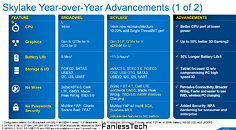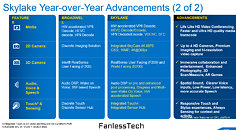Friday, July 24th 2015

Skylake iGPU Gets Performance Leap, Incremental Upgrade for CPU Performance
With its 6th generation Core "Skylake" processors, Intel is throwing in everything it's got, into increasing performance of the integrated graphics. This is necessitated not by some newfound urge to compete with entry-discrete GPUs from NVIDIA or AMD, but a rather sudden increase in display resolutions, after nearly a decade of stagnation. Notebook and tablet designers are wanting to cram in higher resolution displays, such as WQHD (2560 x 1440), 4K (3840 x 2160), and beyond, and are finding it impossible to achieve them without discrete graphics. This is what Intel is likely after. The aftereffect of this effort would be that the iGPU will be finally capable of playing some games at 720p or 900p resolutions, with moderate eye-candy. Games such as League of Legends should be fairly playable, even at 1080p. Intel claims that its 9th generation integrated graphics will over a 50% performance increment over the previous generation.
Moving on to CPU, and the performance-increase is a predictable 10-20% single/multi-thread CPU performance, over "Broadwell." This is roughly similar to how "Haswell" bettered "Ivy Bridge," and how "Sandy Bridge" bettered "Lynnfield." Intel will provide platform support on some of its "Skylake-U" ultraportable variants, for much of the modern I/O used by today's tablets and notebooks, which required third-party controllers, and which competing semi-custom SoCs natively offer, such as eMMC 5.0, SDIO 3.0, SATA 6 Gb/s, PCIe gen 3.0, and USB 3.0. Communications are also improved, with 2x 802.11 ac, Bluetooth 4.1, and WiDi 6.0.
Source:
FanlessTech
Moving on to CPU, and the performance-increase is a predictable 10-20% single/multi-thread CPU performance, over "Broadwell." This is roughly similar to how "Haswell" bettered "Ivy Bridge," and how "Sandy Bridge" bettered "Lynnfield." Intel will provide platform support on some of its "Skylake-U" ultraportable variants, for much of the modern I/O used by today's tablets and notebooks, which required third-party controllers, and which competing semi-custom SoCs natively offer, such as eMMC 5.0, SDIO 3.0, SATA 6 Gb/s, PCIe gen 3.0, and USB 3.0. Communications are also improved, with 2x 802.11 ac, Bluetooth 4.1, and WiDi 6.0.



100 Comments on Skylake iGPU Gets Performance Leap, Incremental Upgrade for CPU Performance
tho i still find the fact of being deceived delusional since even if you went from the higher 1366 to the lowest 2011-v3, even if you took the lowest it should still yeld substantial advantage over ... (one beingt the PRICE... i mean com'on people still try to sell the 980 and 990 above a 5820K price ... ) well the 990X was a bit more efficient (5%) on the tdp but at 999$ versus 389$ i don't think a 5820K has a worse price to perf ratio ..., roger?
apple to apple a 990X successor is a 5960X for me
Don't get me wrong, I don't feel decived, I just feel Intel could be doing a lot more with this die shrink given proper competition...
ok i get your meaning and i agree.
Once I overclocked the 4770k to 4.4 Ghz, it became about twice as fast so it's not a linear comparison.
And then I got a 780ti and haven't had to think about upgrading yet.
I can't imagine going from 920 to 6770, that would be a huge increase.
Clock for clock, I had no decrease in performance going from triple channel to dual channel either, EXCEPT when I mad a RAM Drive, but then again, what's the difference between 8GB/s to 3GB/s? That sounds like a lot, but it made 0 difference in load times on the games I played on that ram Drive.
Unless you take only most CPU bottlenecked games, you'll see no real difference.
Change entire platform for 800-1000 € and gain 2fps or buy a new graphic card for half that and gain 30+ fps... hm...
Same video cards though, those beasts lasted me a long time, loved those Windforce 7950s.
There are various specualtions about eDRAM on Skylakes (probably Skylake-E variants), but no one really knows how they'll use it. Could be just for iGPU and wouldn't make any difference for anything else or they might use it for general CPU tasks and that might be interesting. But other than that, nothing really new worth mentioning. Die shrinks are like "meh" these days really. It's nice to have it, but essentially yawn inducing...
i7 930:
i7 4770k:
So for that benchmark, it went from almost 12 seconds to 7 seconds. Not bad.
Here I'm trying waframe with everything graphical turned down (including resolution) to keep GPUs out of the equation as much as possible.
i7 930:
i7 4770k:
If you check the FPS counter at the bottom, 930 is around 548 fps, while the 4770k is around 847 fps.
Almost double the performance. Okay so it wasn't just me, there is a massive difference.
EDIT 2: Even though I had everything graphical turned down, the GPUs were still being used a lot. The Radeon 7950 with the i7 930 was at 45% usage, and the 780ti with the i7 4770k was at 32% usage, so take those results with HUGE grain of salt man.
I don't know if warframe is the best game for testing if it is noticeable. Yes it shows a real world boost, but you were already at 550 fps. Anything more is not even noticeable. I don't know of any game, but it would be more ideal to have a game that was getting low fps with the 930 and 55% more fps with the 4770k.
I feel like CPUs are no longer a factor in this day & age when considering a PC gaming build. Seems like even if you get a low-end/mainstream CPU and just give it a small OC, it will keep you going for a long time. Case and point, my 2500k has not slowed me down one bit. I might wait for Cannonlake or Zen depending on how AMD plays it's cards this time around.
I've upgraded recently from a Phenom II X4 to a Haswell i5, and although I get ~40% more performance in pure CPU synthetics, 3dmark score has hardly moved and I don't feel any significant improvement in games. There is some improvement during scenes where frame drops, if you usually game with FRAPS on, but nothing which you could notice if FRAPS would be off, and drops and stutter if they were there before they are still there even after the upgrade.
Even badly coded games, which rely heavily on single thread performance, like Starcraft 2, which was the main reason for which I went i5 don't feel that much better. (Badly coded because this game uses ~70% from one core and 40% from another ... rest of them relax doing nothing)
Anyway I upgraded mostly because my platform was very old, because I could find good looking settings which got me over 60 fps in all the games even on the phenom.
BTW I also have a 7850, which I want to upgrade, but again it is because of its age and because at 1GB it has quite low memory, not because it doesn't give me good performance, in fact it is still a monster running flawlessly everything I throw at it.
One more thing about the memory, I don't see how an iGPU even with 128 EDRAM or whatever can compete with a card with dedicated memory. This iGPU stuff is very good for laptops, otherwise for desktop it is completely useless and any reasonable gamer will eventually get a discrete card.
This makes this intel iGPU push very stupid from my perspective, from the same die size they could make 2, maybe 3 CPUs, (even with slower 2d/3d integrated graphics) and sell them a bit cheaper and with much better margins.
:lovetpu:
A Core i7 6700K paired with 32GB of RAM, new AX 760i PSU and new case, probably Corsair Carbide Silent. I'll be keeping the graphic card, soundcard and HDD/SSD. Should be fine for quite some time even without any overclocking. If it'll last for 6 years like this one I'll be happy. Lets wait for august...
And click this for Synth. benchmark from anandtech.
Well, don`t get me wrong, but I just want to make you know about how every generations of i7 improved it`s performance.